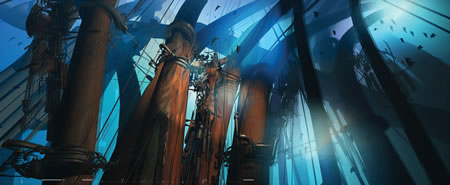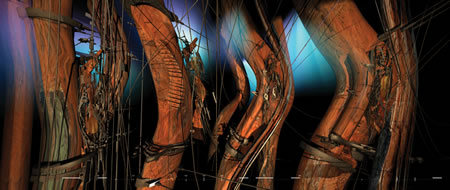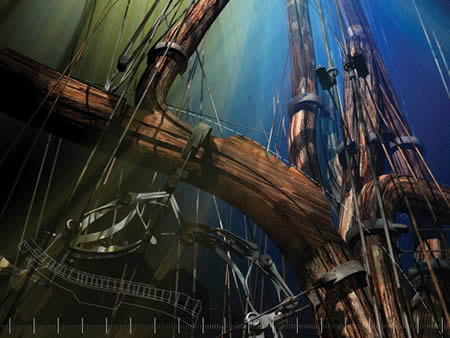 Tomorrow morning BLDGBLOG rolls itself out upon the American interstate highway system to make its slow way over to the apocalypse of Los Angeles – via Chicago, Denver, Boulder, and Springdale, Utah, where a few pints of Polygamy Porter and some long hikes in Zion National Park strongly beckon – all the while hoping to maintain some sort of regular posting schedule, as I have about 2.173 billion things I want to tell everyone about.
Tomorrow morning BLDGBLOG rolls itself out upon the American interstate highway system to make its slow way over to the apocalypse of Los Angeles – via Chicago, Denver, Boulder, and Springdale, Utah, where a few pints of Polygamy Porter and some long hikes in Zion National Park strongly beckon – all the while hoping to maintain some sort of regular posting schedule, as I have about 2.173 billion things I want to tell everyone about. First off, British architect Norman Foster "has been enlisted by the King of Jordan for his most grandiose project yet – a canal carved through the desert to rescue the Dead Sea from environmental disaster." Foster's plan "is to carry sea water from the Gulf of Aqaba to replenish the Dead Sea, which has shrunk by a third over the past 50 years and faces total evaporation." The water will travel through a "sequence of canals and pipelines," moving "down through the arid Arava valley in southern Israel and Jordan to the salt lake at the lowest point on earth, 415 meters below sea level.”
We wish him luck – then we refer you to the great man-made river of Libya.
 Elsewhere, metallic, alcohol-detecting flowers have been "grown in a laboratory in China." These "spectacular flower-like nanostructures" are each "made up of bundles of nanorods 15nm wide. They were made by blasting a zinc-containing solution with ultrasound."
Elsewhere, metallic, alcohol-detecting flowers have been "grown in a laboratory in China." These "spectacular flower-like nanostructures" are each "made up of bundles of nanorods 15nm wide. They were made by blasting a zinc-containing solution with ultrasound." This bouquet even conducts electricity: "To make a sensor the researchers wired up two patches of the flowers into a circuit."
Next up: the flowers escape and cross-breed with uranium, forming an unkillable flowering alloy that soon decimates New York City. Within ten years, the cities of North America resemble a metallized return to the Jurassic era, complete with bio-iron vines and moving fogs made entirely from electricity...
As you ponder that fate, check out Architecture Radio's podcast of a talk by Steven Ehrlich, an architect based in Culver City, Los Angeles; then give a listen to AR's earlier lecture by border-crossing architect Teddy Cruz. Then, while your ears recover, this video-tour of a data storage warehouse is worth a minute or two of your time.
Equinix Internet Business Exchange centers, we see, "serve as core hubs for critical IP networks and Internet operations worldwide." They are huge, air-conditioned warehouses full of humming CPUs and bundled cables, watched over by CCTV.
- With direct access to more than 200 networks, including all of the top global Tier 1 networks, Equinix's network-neutral IBX centers and services overcome the limitations of existing data center, network and Internet operations through direct interconnection to the largest aggregation of networks for unmatched service diversity, flexibility and reliability. At Equinix, customers can directly access the providers that serve over 90% of the world’s Internet networks and users.
 Finally, Christian Kerrigan wants to grow a living ship from the trees of Kingley Vale forest: "By controlling the manipulation of refined armatures, calibrating devices and designed corsets," Interactive Architecture dot Org reports, "the system is capable of controlling the growth of a ship inside the forest. The ship will grow over a period of two hundred years and will exist as a hidden architecture inside the trees."
Finally, Christian Kerrigan wants to grow a living ship from the trees of Kingley Vale forest: "By controlling the manipulation of refined armatures, calibrating devices and designed corsets," Interactive Architecture dot Org reports, "the system is capable of controlling the growth of a ship inside the forest. The ship will grow over a period of two hundred years and will exist as a hidden architecture inside the trees."In other words, using hinged networks of cables and steel restraining belts, the growing branches of trees can be forced to assume the shape of a masted ship.
Is it the self-pruning future of architecture...?

 We wish him luck, as well.
We wish him luck, as well. More soon... And I'll try to keep posting from the road.
(Earlier: Quick list 3, et cetera).
No comments:
Post a Comment